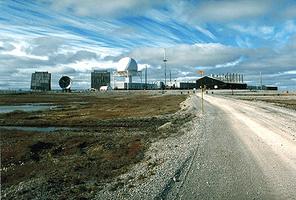
Although the USSR's military capabilities did not yet extend to launching a massive air bombardment on North America, in 1946 Canadian authorities began to consider the problem of building a radar chain in the Far North to guard against the possibility of Soviet attack. However, existing technology could not guarantee complete coverage of the northern frontier and would not permit accurate tracking of hostile aircraft once they had passed over the Arctic coast on their way to potential targets in southern Canada. Since this would leave the air force's fighter units without reliable information, it seemed unwise to spend vast sums on an ineffective early-warning system. The idea was shelved in 1947.
Conditions had changed by 1949. The USSR had developed its own atomic bomb and was in the process of creating a long-range bomber force. This, coupled with increased East-West tensions in Europe, convinced the Canadian government that it should construct a radar line, this time farther south, to provide early warning of an attack. The US decided to build a similar chain on its northern border that same year. Joint discussion eventually led to a co-operative effort, the Pinetree Line. Completed in 1954 for $450 million (of which Canada paid $150 million), it was a network of 33 stations running from Vancouver I through Alberta, northern Ontario and Québec to the Labrador coast. Eleven stations were financed and manned by Canada, and a further 5 were staffed by Canadians but paid for by the US.
Interest in improving North American radar coverage grew as the USSR upgraded its bombers in the early 1950s. In February 1953 Defence Minister Brooke Claxton discussed the construction of an arctic chain with the Eisenhower administration, but no decisions were made. When the Soviets exploded their first hydrogen (thermonuclear) bomb in August 1953 the question became more urgent. Instead of an arctic chain, however, Canadian defence-research scientists recommended the construction of a mostly unmanned radar warning system (the McGill Fence) at 55° N to complement Pinetree. Louis St. Laurent's government accepted the advice in June 1954 and proceeded with this all-Canadian Mid-Canada Line project because technology was available in Canada, the line was cheaper than an arctic chain, and the plan avoided the troublesome issue of American presence on Canadian soil. Ninety-eight Mid-Canada stations were built by 1957 at a total cost of $250 million.
The idea of an arctic early-warning chain was not dropped. In June 1954 the Canada-US Military Studies Group - a bilateral advisory body under the aegis of the Permanent Joint Board on Defence - urged that such a network be built because the USSR could outflank both the Pinetree and Mid-Canada lines. Under pressure from the US, and receiving similar advice from the RCAF, the federal government ultimately accepted the need for a radar chain in the Far North, and in Nov 1954 Canada and the US agreed to the construction of the Distant Early Warning (DEW) Line along the Arctic coast from Alaska to Baffin Island.
The US would bear the full cost of construction but had to employ Canadian firms and native labour. Canada also retained ownership of the sites located in Canada, and the major stations were to be commanded by Canadians. Stretching 8046 km (5944 in Canada), the 22-station DEW Line was completed in 1957 after a massive construction engineering job that employed over 25 000 people. Such extensive co-operation between Canada and the US to solve the common problem of North American air defence was an important first step in the creation of the bilateral North American Air Defence Command (NORAD) in 1958, which integrated all Canadian air-defence radars and fighter forces.
The importance of these radar lines decreased substantially almost as soon as they had been completed. Intercontinental and submarine-launched missiles, against which all 3 early-warning lines were useless, began to replace the manned bomber as the main Soviet threat in the early 1960s and a Ballistic Missile Early Warning System (BMEWS) was constructed in Alaska and Greenland. Satellites and BMEWS took over as the primary attack early-warning system. As a result the Mid-Canada Line was phased out of service in 1965, and in subsequent years 9 Pinetree stations were closed. By 1983, 21 modernized DEW Line stations and 24 Pinetree stations remained in operation to maintain sovereignty over Canada's airspace and to detect any Soviet aircraft undertaking a bombing raid on North America in conjunction with or following a ballistic missile attack.
The development of the Cruise missile, a low-flying weapon that could avoid detection by the DEW and Pinetree lines, reawakened interest in arctic air defence in the early 1980s. In the spring of 1985, following the Shamrock Summit between PM Mulroney and US President Reagan, the 2 countries agreed to complete a modern radar line, the North Warning System, to replace the DEW and Pinetree chains, along Canada's Arctic coast at about 70° N. Consisting of 52 stations (47 in Canada, of which 11 would be manned), and expected to cost $1.5 billion (of which Canada's share would be $600 million), the new chain was designed to detect low-flying aircraft and missiles, and to pass information directly by satellite to NORAD headquarters. Additional detection capabilities would be provided by radar warning and control aircraft (AWACS), and long-range over-the-horizon radars on the eastern and western perimeters of North America. To facilitate interception and identification of unidentified objects, 5 airfields in Canada's Far North were to be upgraded to permit operations by Canadian CF-18 fighters. Fiscal restraint delayed the upgrading of one airfield, but those at Inuvik, Yellowknife, Rankin Inlet, and Iqaluit were able to support CF-18 operations by mid-1994.

 Share on Facebook
Share on Facebook Share on X
Share on X Share by Email
Share by Email Share on Google Classroom
Share on Google Classroom
